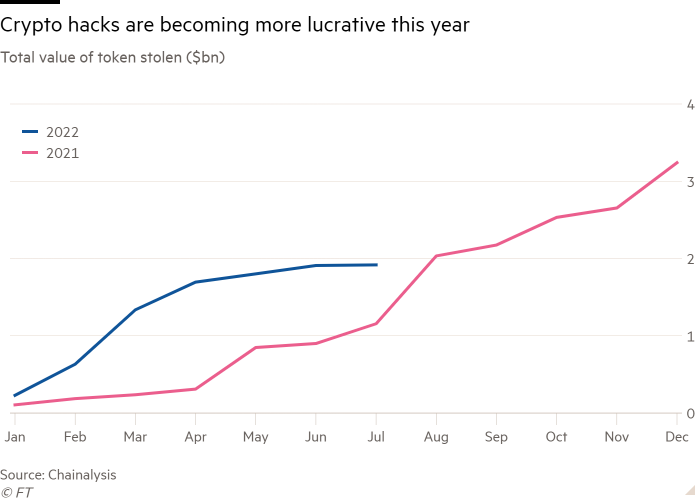Bitcoin prices have been steadfastly earthbound since June’s crypto credit crunch rather than going to the moon.
The world’s most actively traded digital token has been hovering at around $21,000-$24,000 in the last six weeks, a haven of relative tranquility after the rollercoaster of the last two years.
For believers, a pause was perhaps needed after a 70 per cent drop in value since November. The memory of May and June — when the collapse of the now infamous (un)stablecoin terra and its counterpart luna crashed prices and claimed companies such as Three Arrows Capital, Voyager Digital and Celsius — is still raw.
The last nine months have helped put to bed some of the optimistic claims made on bitcoin’s behalf. It’s not a hedge against inflation, or digital gold, or a substitute for US tech stocks, which also enjoyed outsized gains after the pandemic. In the last six months, the Nasdaq has dropped 4 per cent while bitcoin is down a whopping 46 per cent, according to Refinitiv.
But as pointed out by Jeff Dorman, chief investment officer at asset management firm Arca, “bitcoin is stuck”.
In the same six week period, equities have rebounded as have digital tokens such as ether, Uniswap, AAVE and Matic, as investors look for signs of optimism. Not so with bitcoin.
“Bitcoin . . . has completely lost its narrative — it is not an inflation hedge, it is not uncorrelated and it does not act defensively. As a result, with no narrative of its own, bitcoin has traded as ‘Nasdaq beta’ and will continue to until it regains a new narrative,” said Dorman.
What is that narrative to focus on? It started life as a censorship-resistant tool to bypass regulation. It still hasn’t been hacked, but neither has it found any real utility.
Its pseudonymous creator Satoshi Nakamoto envisaged it as a “peer-to-peer electronic cash system”, but that dream remains as far away as ever. Yes, bitcoin became legal tender for the first time last year when El Salvador adopted the cryptocurrency, but it’s not in widespread use. Considerable technical barriers like scalability remain. Even Sam Bankman-Fried, chief executive of crypto exchange FTX, says it has no future as a payments system.
“If the price of bitcoin remains stable relative to a basket of goods, then yes on a pure theoretical basis it could be a medium of exchange”, computer programmer and outspoken crypto critic Stephen Diehl told me, with the caveat that even six months would not be a long enough sample period to be certain.
But the paradox of bitcoin is that if it is stable enough to be used as a medium of exchange, it is a poor investment because the value doesn’t appreciate.

Market developments indicate bitcoin is still seen as a speculative asset. Only last week, BlackRock, the world’s largest asset manager, launched a bitcoin private trust citing “substantial interest” from clients despite the fact that digital assets have dropped off a cliff since peaking in November 2021.
Previous collapses have resulted in huge rises a few years down the line, a fact that invites speculation that this lull could allow time to prepare for another bull run.
“Big asset managers are now under more pressure to provide crypto to their clients . . . the prices are easier to stomach and sophisticated investors know you buy after a massive crash,” Aaro Capital chief executive Peter Habermacher told me. “We don’t see bitcoin as digital cash. Traditional fiat and stablecoins are better means of payment.”
Still, it takes a brave investor to dive in right now. A world of high inflation and rising interest rates is new ground for the crypto industry.
“It’s a tenuous backdrop still for risk assets, with the Fed and inflation picture likely to continue through the rest of this year,” said Dan Ives, senior equity analyst at Wedbush Securities.
Maybe it doesn’t pay to overanalyse the movements of cryptocurrency prices and the main priority is to be well-positioned for the moment it does blast off. Even so, bull runs need the rocket fuel of a decent narrative to sustain them.
The week’s highlights
-
Don’t miss this FT Tech Tonic podcast that looks back on the crypto market’s drastic fall from grace. My colleague Jemima Kelly and I take you through the unravelling of digital assets from the collapse of terra and talk to one “rekt” crypto investor who still can’t admit just how much money he lost. Jemima asked MicroStrategy executive chair and bitcoin fanatic Michael Saylor what if he was wrong to buy billions worth of bitcoin? “We would already be out of business if we hadn’t done it,” Saylor said.
-
A dispute between Galaxy Digital, one of the industry’s biggest investment management firms, and custodian BitGo went public. Galaxy, led by (reformed?) Luna-tic Mike Novogratz, was meant to acquire BitGo in a deal worth $1.2bn. After months of delays Galaxy called it off, alleging that BitGo failed to provide audited financial statements. BitGo hit back. Its legal counsel said it was an “improper decision” to terminate, adding: “Either Galaxy owes BitGo a $100mn termination fee as promised or it has been acting in bad faith and faces damages of that much or more.”
-
Make sure you read my colleague Kadhim Shubber’s fantastic Celsius scoop on Alex Mashinksy taking control of the crypto lender’s trading strategy in January.
-
Still more waves are reaching shore from the fallout of the collapsed crypto hedge fund Three Arrows Capital, which plunged into bankruptcy in July. Genesis is the crypto brokerage that lent nearly $2.5bn to the now-bankrupt Singapore group. Its chief executive Michael Moro is leaving after six years in the role and a fifth of its 260-strong workforce is going.
-
Crypto platform Hodlnaut (no, me neither) is the latest to be caught out by the terra-luna crash. After halting operations earlier this month, it’s now laid off four-fifths of its staff (around 40 people) and is seeking bankruptcy protection in Singapore, as it doesn’t want to do a forced liquidation of its crypto assets in a depressed market. Users shouldn’t get too hopeful. One of the prepared FAQs asked: “Is my money all gone?” The company responded: “No, while Hodlnaut is facing a difficult financial situation at the moment, not all your assets are gone.”
Soundbite of the week: CDPQ closes the door on further crypto investments
Hindsight is 20/20. Canadian pension fund giant Caisse de dépôt et placement du Québec (CDPQ) wrote off all of its $150mn investment last October in Celsius, the now-collapsed crypto lending platform led by Alex “unbank yourself” Mashinksy. CDPQ chief Charles Emond tried to explain:
“For us it’s clear when we look at all of this. . . that we went in too soon into a sector that was in transition, with a business that had to manage extremely quick growth.”
Data mining
This year is the year for crypto hacks, a survey of crypto crime from blockchain analytics firm Chainalysis concludes.
It took cyber criminals roughly seven months to break the $1bn threshold for total crypto hacked last year. This year, they’ve managed to smash through that barrier in just three months. By the end of last month, hackers had pocketed almost $2bn collectively, Chainalysis found. North Korean-state sponsored groups have been particularly active, stealing around $1bn from DeFi protocols.
The data also found crypto-related scam “revenue” is down significantly — about 65 per cent lower this year compared with July last year.
That’s hardly surprising given that ordinary investors have departed the market as it collapsed. Still, it seems if you can’t scam a scammer, you can at least hack them.

from Cryptos Updates – usanewsplug Wordpress
via IFTTT
